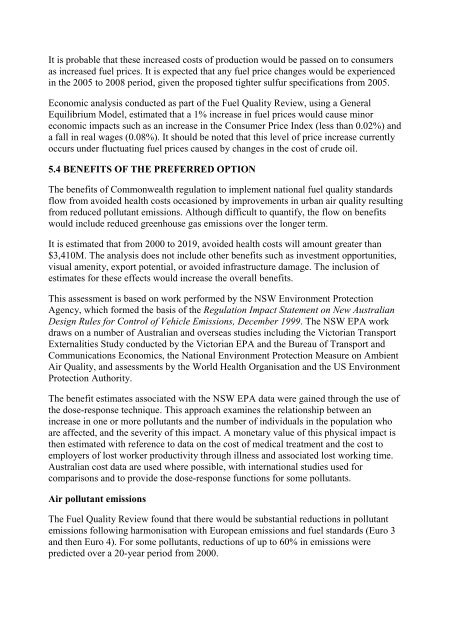National Fuel Quality Standards Regulation Impact Statement 1 ...
National Fuel Quality Standards Regulation Impact Statement 1 ...
National Fuel Quality Standards Regulation Impact Statement 1 ...
You also want an ePaper? Increase the reach of your titles
YUMPU automatically turns print PDFs into web optimized ePapers that Google loves.
It is probable that these increased costs of production would be passed on to consumers<br />
as increased fuel prices. It is expected that any fuel price changes would be experienced<br />
in the 2005 to 2008 period, given the proposed tighter sulfur specifications from 2005.<br />
Economic analysis conducted as part of the <strong>Fuel</strong> <strong>Quality</strong> Review, using a General<br />
Equilibrium Model, estimated that a 1% increase in fuel prices would cause minor<br />
economic impacts such as an increase in the Consumer Price Index (less than 0.02%) and<br />
a fall in real wages (0.08%). It should be noted that this level of price increase currently<br />
occurs under fluctuating fuel prices caused by changes in the cost of crude oil.<br />
5.4 BENEFITS OF THE PREFERRED OPTION<br />
The benefits of Commonwealth regulation to implement national fuel quality standards<br />
flow from avoided health costs occasioned by improvements in urban air quality resulting<br />
from reduced pollutant emissions. Although difficult to quantify, the flow on benefits<br />
would include reduced greenhouse gas emissions over the longer term.<br />
It is estimated that from 2000 to 2019, avoided health costs will amount greater than<br />
$3,410M. The analysis does not include other benefits such as investment opportunities,<br />
visual amenity, export potential, or avoided infrastructure damage. The inclusion of<br />
estimates for these effects would increase the overall benefits.<br />
This assessment is based on work performed by the NSW Environment Protection<br />
Agency, which formed the basis of the <strong>Regulation</strong> <strong>Impact</strong> <strong>Statement</strong> on New Australian<br />
Design Rules for Control of Vehicle Emissions, December 1999. The NSW EPA work<br />
draws on a number of Australian and overseas studies including the Victorian Transport<br />
Externalities Study conducted by the Victorian EPA and the Bureau of Transport and<br />
Communications Economics, the <strong>National</strong> Environment Protection Measure on Ambient<br />
Air <strong>Quality</strong>, and assessments by the World Health Organisation and the US Environment<br />
Protection Authority.<br />
The benefit estimates associated with the NSW EPA data were gained through the use of<br />
the dose-response technique. This approach examines the relationship between an<br />
increase in one or more pollutants and the number of individuals in the population who<br />
are affected, and the severity of this impact. A monetary value of this physical impact is<br />
then estimated with reference to data on the cost of medical treatment and the cost to<br />
employers of lost worker productivity through illness and associated lost working time.<br />
Australian cost data are used where possible, with international studies used for<br />
comparisons and to provide the dose-response functions for some pollutants.<br />
Air pollutant emissions<br />
The <strong>Fuel</strong> <strong>Quality</strong> Review found that there would be substantial reductions in pollutant<br />
emissions following harmonisation with European emissions and fuel standards (Euro 3<br />
and then Euro 4). For some pollutants, reductions of up to 60% in emissions were<br />
predicted over a 20-year period from 2000.
















